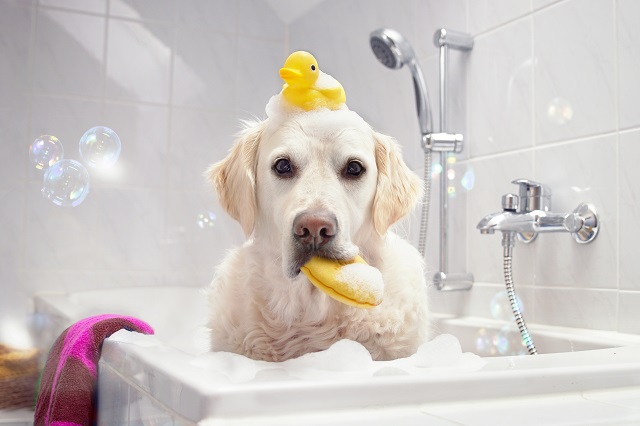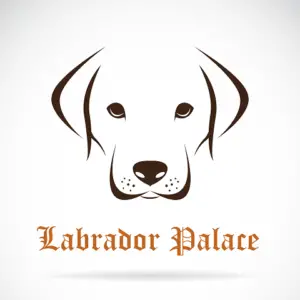As soon as you get your Vet’s clearance, it is recommended that you bathe them one to two times a week until you see either a marked improvement in their condition or you need to return to your Vet for further advice.
Labrador Retriever Allergies – How Often To Bathe: Just like humans, dogs can also suffer from allergies. There are certain dog breeds, however, that are more likely to have allergies than others.
There are three common symptoms of skin issues in Labs: itching, scratching and biting. By far, allergic reactions cause the majority of skin issues in Labs.
Labrador Retrievers are often prone to scratching and allergic reactions. There are a number of measures you can take to prevent this.
http://www.acvd.org/pages/category.asp?ids=27_Alergic_Skin_Disease
Here is a list of the main Allergies your Labrador could face:
| Seasonal allergies | Food |
| Fleas | Chemical contact |
| Medication | Fabric |
Seasonal allergies
Several of the same seasonal allergens that affect people may also impact your lab. Among these are pollen, leaves, mold, dirt, and weeds.
Your Labrador Retriever’s skin allergies are usually caused by grass pollen. In addition to the use of dog shampoo for allergies, air purifiers may minimize allergies.
Fleas
Even one or two of these parasites or their bites can cause a skin allergy in your Lab, causing bumpy marks to develop on the body. This can make your Labrador extremely itchy.
Medication
A number of antibiotics and vaccines can also cause an allergic reaction resulting in hives. Most of the time, these hives disappear after a day or two. Nevertheless, a dog’s allergy shampoo can help in the case when they don’t.
Food
Intolerance to certain foods is another likely trigger of your allergic reaction to Labradors. There are a number of common foods that dogs are allergic to, such as beef, soy, wheat and dairy products.
Chemical Contact
You should check your dog’s skin if they have been exposed to household cleaning products or other chemicals.
You should be cautious when using chemicals where your Labrador walks, sleeps and eats. There are things you can do at home to avoid and relieve minor itching, such as bathing before a secondary infection develops. Otherwise, you should contact a veterinarian.
Here are some simple ways to prevent dog allergies via bathing. We will also look into shampoos and other grooming products that may cause problems.
How to Bath Your Labrador Retriever.
With a Labrador without allergies, it is recommended to wash them once every 10 to 14 days.
Your Labrador Retriever may benefit from a bath more frequently if you’re an active person and walk it outside frequently. However, it’s not absolutely necessary. Please consult your veterinarian if your Lab has a skin condition or allergy before you apply any of these methods.
In some cases, your Lab may benefit from less bathing or more frequent bathing, so always consult your veterinarian first.
Upon your Vet’s approval, it is recommended they be bathed one to two times every week until they are either improving significantly or you need to visit your Vet again for more advice.
Some Simple Tips If Your Labrador Is Not Use To Bathing
You should work on introducing your Lab to a bath when he is still a puppy since bathing a nervous and anxious puppy is much simpler than a 27-pound dog. However, regardless of whether you have a pup or an older dog, the introduction is pretty similar.
Put your Labrador in one or two inches of water first and let it sit there for a little while. Praise them and give them a couple of treats. Bathing should be a pleasant experience for your Lab.
Pour a gentle stream of water across their back when they are relaxed. Do not rush through this step. It will take a little time for your Labrador Retriever to adjust.
You can slowly increase the amount of water in the bath as your Labrador becomes accustomed to the sensation. You can do this several times until they are comfortable with the sensation.
What You Will Need To Wash Your Lab
| Shampoo Shower or Bathtub | Lukewarm water |
| Towel | Brush |
| Alternatives Shampoo | Patience |
Steps for Bathing Your Labrador Retriever
- Brush your Labrador Retriever: If your dog has allergies, you need to brush them very gently. Rubber brushes do not cause their skin to be as sensitive to damage as regular bristle brushes.
- Use lukewarm water: Dogs have different skin than humans, so hot water can easily harm them. The temperature of the bathwater should not exceed what a baby would experience in a bath. Rinse your lab well with water. To make sure water doesn’t get inside their ears, place some cotton wool buds in their ears.
- Reassure your Lab: Communicate calmly and soothingly with your dog. Although some Labs will keep hiding under the dining room table whenever you get a towel, most will soon learn that you aren’t out to terrorize them.
- Apply Shampoo: Make a gentle lather with the shampoo, then rub it over your dog’s body, being careful not to get anything in their eyes.
- Rinse well: Your Lab’s skin may be irritated by shampoo that remains in their coat once they are dry. Please make sure that you thoroughly rinse them.
- Air-dry: Hairdryers that you use for yourself will be too hot for your dog. Use only low temperatures. The cooler temperatures will not cause itchiness or dandruff when air-dried or using a blow-dryer designed for dogs.
- Reward them: Give lots of praise, petting, or play. It is not uncommon for wet Labradors to vent their post-bath angst by playing tug-of-war or getting sudden attacks of the zoomies.
Allergy Shampoos
To keep these skin issues under control, your veterinarian might have advised frequent bathing and shampoo treatments. These include allergies that can cause dandruff, yeast infections, or bacterial infections, including allergies to food and the environment.
In order to treat allergic skin disease with shampoo, allergens are removed from the skin, hydrating it, and reducing the presence of bacteria and yeast. The market is flooded with dog shampoos that target skin allergies specifically. Dogs can benefit from such shampoos in several ways, such as reducing symptoms of skin allergies or increasing their allergy tolerance.
These shampoos are very gentle on the skin since they contain organic ingredients like aloe vera and tea tree oil. Aloe vera is generally very calming and soothing, reducing irritation, and reducing dry, flaky skin well. Aside from moisturizing ingredients, certain shampoos are also made with ingredients that can be beneficial for the treatment of such dry skin.

pH Balance
If you want to ensure that the pH balance of your Lab’s skin and coat is preserved, you must use a dog-specific shampoo.
It is recommended that dogs with skin allergies use shampoo with a pH level of seven. You can find the pH level on the label of the shampoo. Make sure to stay clear of brands that fail to disclose their dog shampoo’s pH.
Ingredients To Look For
| Lemongrass | Rosemary |
| Lavender | Chamomile |
| Eucalyptus | Aloe Vera |
What To Avoid
With the wide range of shampoos available for Labrador Retrievers, you’ll find one that’s right for them. However, you should be aware that not all dog shampoos are formulated in the same way.
The ingredients in some of them may irritate or damage your Lab’s skin.
Because of this, it is always advisable to read the ingredients in shampoo bottles. This product may not be suitable for your lab if it has synthetic fragrances and coloring.
Shampoo made for humans should not be used. Dogs have much more sensitive skin than humans. In either case, many human shampoos merely remove natural oils from dogs’ skin.
What Is A Medicated Dog Shampoo
Medicated shampoos are still recommended by veterinarians for a variety of reasons.
A medicated dog shampoo is most commonly used throughout the treatment of yeast infections and bacterial infections. There are three main signs of diseases: hair loss, crusty skin, and itchy skin.
In the case that your Lab is quite stressed, a dog treatment that relieves their symptoms may help them feel more relaxed and heal more quickly.
If your dog is susceptible to skin infections, your veterinarian will recommend an antibacterial or antifungal shampoo that can eliminate the current infection and prevent new infections from occurring.
Steps for Bathing Your Labrador Retriever with Medicated Shampoo
A few more steps must be taken for Medicated Shampoo in addition to the usual steps for regular and anti-allergic shampoos.
- It is important to use a medicated shampoo on a clean, wet coat, so thoroughly wash your Lab’s coat before administering the remedy.
- To avoid dirt and debris, bathe your Labrador Retriever with an over-the-counter shampoo if they’re particularly dirty. Choose an antiallergen shampoo if your dog is particularly dirty.
- Begin working the medicated shampoo into affected areas of your Labrador Retriever’s coat after it is cleaned and wet. The most likely locations are the paws, the underarms, and the groin. As soon as you have thoroughly massaged the shampoo in these areas, you should move on to the rest of your dog’s coat.
- Set your alarm for ten minutes after your Lab has been properly cleaned with shampoo. After the timer goes off, rinse thoroughly. It is extremely important that you thoroughly wash the shampoo from all areas of your dog’s body. It is important not to leave too much shampoo on the dog’s body during this step.
- It generally takes a few weeks for skin conditions to improve. Depending on your pet’s specific skin condition, your veterinarian can give you some idea of what to expect.
Conclusion
Your dog will need ongoing allergy treatment for most of his adult life in order to control his allergies. The skin, eye, and ear can develop secondary infections and need treatment despite your efforts.
Ensure that your pet receives quality care consistently. Coordinate your care with your veterinarian. Respond to issues as they arise. If you are committed to the well-being of your dog, it will cherish your care.

